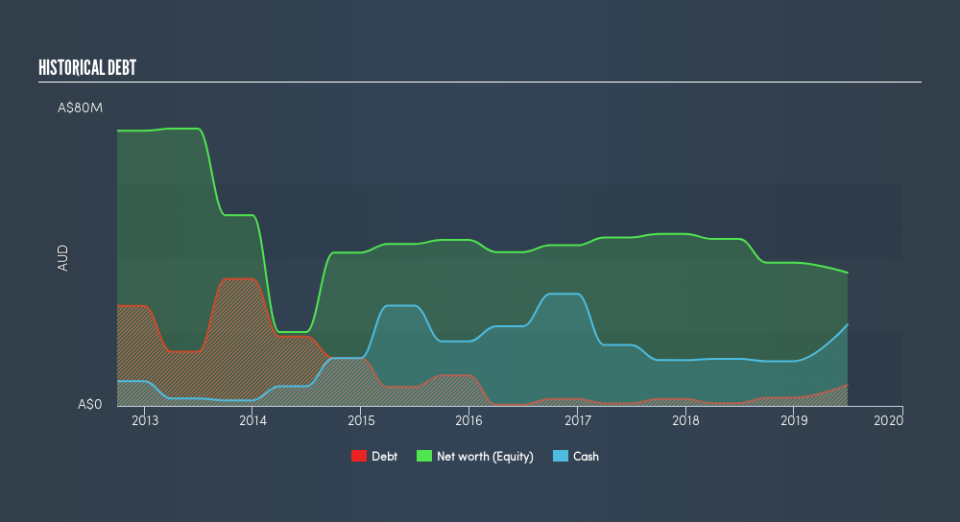Does BSA (ASX:BSA) Have A Healthy Balance Sheet?

Legendary fund manager Li Lu (who Charlie Munger backed) once said, 'The biggest investment risk is not the volatility of prices, but whether you will suffer a permanent loss of capital.' So it might be obvious that you need to consider debt, when you think about how risky any given stock is, because too much debt can sink a company. As with many other companies BSA Limited (ASX:BSA) makes use of debt. But the real question is whether this debt is making the company risky.
When Is Debt A Problem?
Debt assists a business until the business has trouble paying it off, either with new capital or with free cash flow. In the worst case scenario, a company can go bankrupt if it cannot pay its creditors. However, a more common (but still painful) scenario is that it has to raise new equity capital at a low price, thus permanently diluting shareholders. Having said that, the most common situation is where a company manages its debt reasonably well - and to its own advantage. When we think about a company's use of debt, we first look at cash and debt together.
Check out our latest analysis for BSA
What Is BSA's Debt?
The image below, which you can click on for greater detail, shows that BSA had debt of AU$987.0k at the end of June 2019, a reduction from AU$5.70m over a year. However, its balance sheet shows it holds AU$21.9m in cash, so it actually has AU$21.0m net cash.
How Healthy Is BSA's Balance Sheet?
We can see from the most recent balance sheet that BSA had liabilities of AU$107.0m falling due within a year, and liabilities of AU$7.48m due beyond that. On the other hand, it had cash of AU$21.9m and AU$71.8m worth of receivables due within a year. So its liabilities total AU$20.8m more than the combination of its cash and short-term receivables.
Since publicly traded BSA shares are worth a total of AU$145.5m, it seems unlikely that this level of liabilities would be a major threat. But there are sufficient liabilities that we would certainly recommend shareholders continue to monitor the balance sheet, going forward. While it does have liabilities worth noting, BSA also has more cash than debt, so we're pretty confident it can manage its debt safely.
In addition to that, we're happy to report that BSA has boosted its EBIT by 83%, thus reducing the spectre of future debt repayments. When analysing debt levels, the balance sheet is the obvious place to start. But ultimately the future profitability of the business will decide if BSA can strengthen its balance sheet over time. So if you're focused on the future you can check out this free report showing analyst profit forecasts.
Finally, a company can only pay off debt with cold hard cash, not accounting profits. While BSA has net cash on its balance sheet, it's still worth taking a look at its ability to convert earnings before interest and tax (EBIT) to free cash flow, to help us understand how quickly it is building (or eroding) that cash balance. In the last three years, BSA created free cash flow amounting to 14% of its EBIT, an uninspiring performance. That limp level of cash conversion undermines its ability to manage and pay down debt.
Summing up
While BSA does have more liabilities than liquid assets, it also has net cash of AU$21m. And we liked the look of last year's 83% year-on-year EBIT growth. So we are not troubled with BSA's debt use. Over time, share prices tend to follow earnings per share, so if you're interested in BSA, you may well want to click here to check an interactive graph of its earnings per share history.
If, after all that, you're more interested in a fast growing company with a rock-solid balance sheet, then check out our list of net cash growth stocks without delay.
We aim to bring you long-term focused research analysis driven by fundamental data. Note that our analysis may not factor in the latest price-sensitive company announcements or qualitative material.
If you spot an error that warrants correction, please contact the editor at editorial-team@simplywallst.com. This article by Simply Wall St is general in nature. It does not constitute a recommendation to buy or sell any stock, and does not take account of your objectives, or your financial situation. Simply Wall St has no position in the stocks mentioned. Thank you for reading.


